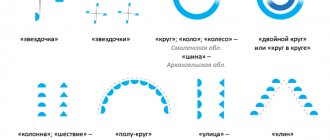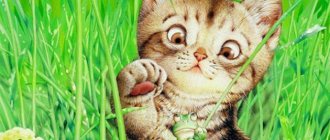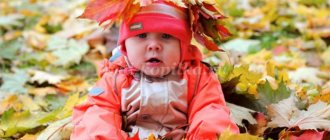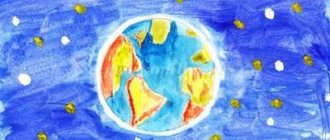Fox with a rolling pin (Russian fairy tale)
The fox was walking along the path and found a rolling pin. She picked it up and moved on.
She came to the village and knocked on the hut: “Knock, knock, knock!” - Who's there? - Me, little fox-sister! Let me spend the night! “It’s cramped here without you.” - Yes, I won’t displace you: I’ll lie down on the bench myself, my tail under the bench, the rolling pin under the stove.
They let her in. So she lay down on the bench herself, her tail under the bench, the rolling pin under the stove. Early in the morning the fox got up, burned her rolling pin, and then asked: “Where is my rolling pin?” Give me some chicken for her! Man - there is nothing to do! - I gave her a chicken for a rolling pin.
The fox took the chicken and walked and sang: “The fox was walking along the path, she found a rolling pin, and she took the chicken by the rolling pin!” She came to another village: “Knock-knock-knock!” - Who's there?
- Me, little fox-sister! Let me spend the night! “It’s cramped here without you.” - Yes, I won’t push you aside: I’ll lie down on the bench myself, tail under the bench, chicken under the stove. They let her in.
The little fox lay down on the bench, her tail under the bench, and the chicken under the stove. Early in the morning the fox slowly got up, grabbed the chicken, ate it, and then said: “Where is my chicken?” Give me a piece for it! There was nothing to be done, the owner had to give her a piece of chicken for the chicken.
Reading list for the middle group!
Educational field "Reading fiction"
Contents of the educational area “Reading fiction”
aimed at achieving the goal of developing interest and need for reading
perception) of books through solving the following problems:
• formation of a holistic picture of the world, including primary value
representations;
• development of literary speech;
• introduction to verbal art, including the development of artistic
perception and aesthetic taste.
Formation of interest and need for reading
- Continue to create interest in the book.
- Continue reading fiction and educational books to your children regularly.
- To develop an understanding that you can learn a lot of interesting things from books.
- Offer children illustrated editions of familiar works.
- Explain how important drawings are in a book; show how much interesting things can be learned by carefully looking at book illustrations.
- Continue to teach children to listen to fairy tales, stories, poems; remember small and simple rhymes.
- Help them. using different techniques and pedagogical situations, correctly perceive the content of the work, empathize
to his heroes.
- At the child’s request, read out a favorite passage from a fairy tale, short story, or poem, helping to develop a personal relationship with the work.
- Maintain attention and interest in the word in a literary work.
- Introduce books designed by Yu. Vasnetsov and E. Rachev. E. Charushin.
Reading lists
children of the middle group (4-5 years old)
Russian folklore
Songs, nursery rhymes, chants
. “Our goat...”; “Little cowardly bunny...”: “Don! Don! Don!”, “Geese, you are geese...”; “Legs, legs, where have you been?..” “The bunny is sitting, sitting...”, “The cat went to the stove...”, “Today is the whole day...”, “Little lambs...”, “A fox is walking along the bridge...”, “Bucket sun...”, “Go, spring, go , red..."
Fairy tales.
“About Ivanushka the Fool”, arr. M. Gorky; “The War of Mushrooms and Berries”, arr. V. Dahl; “Sister Alyonushka and brother Ivanushka”, arr. L. N. Tolstoy; “Zhiharka”, arr. I. Karnaukhova; “Sister Fox and the Wolf”, arr. M. Bulatova; “Zimovye”, arr. I. Sokolova-Mikitova; "The Fox and the Goat", arr. O. Kapitsa; “The Picky One”, “The Lapotnitsa Fox”, arr. V. Dahl; “The Cockerel and the Bean Seed”, arr. Oh, Kapitsa.
Folklore of the peoples of the world
Songs.
“Fish”, “Ducklings”, French, arr. N. Gernet and S. Gippius; "Chiv-chiv, sparrow", trans. with Komi-Permyats. V. Klimova; "Fingers", trans. with him. L, Yakhina; “The Bag”, Tatars., trans. R. Yagofarov, retelling by L. Kuzmin.
Fairy tales.
"The Three Little Pigs", trans. from English S. Mikhalkova; "The Hare and the Hedgehog", from the Brothers Grimm's Fairy Tales, trans. with him. A. Vvedensky, ed. S. Marshak; “Little Red Riding Hood”, from the fairy tales of C. Perrault, trans. from French T. Gabbe; Brothers Grimm. "Musicians of Bremen", German, trans. V. Vvedensky, ed. S. Marshak.
Works of poets and writers of Russia
Poetry.
I. Bunin. “Leaf Fall” (excerpt); A. Maikov. "Autumn leaves in the wind
circling..."; A. Pushkin. “The sky was already breathing in autumn...” (from the novel “Eugene Onegin”); A. Fet. "Mother! Look out the window..."; Ya. Akim. "First snow"; A. Barto. "We left"; S. Drozhzhia. “Walking in the street...” (from the poem «
In a peasant family"); S. Yesenin. “Winter sings and screams...”; N. Nekrasov. “It is not the wind that rages over the forest...” (from the poem “Frost, Red Nose”); I. Surikov. "Winter"; S. Marshak. “Luggage”, “About everything in the world”, “He’s so absent-minded”, “Ball”; S. Mikhalkov. "Uncle Styopa"; E. Baratynsky. “Spring, spring” (abbr.); Yu. Moritz. "Song about
fairy tale"; “The gnome’s house, the gnome is home!”; E. Uspensky. "Destruction"; D. Harms. "A very scary story."
Prose.
V. Veresaev. "Brother"; A. Vvedensky. “About the girl Masha, the dog Cockerel and the cat Thread” (chapters from the book); M. Zoshchenko. "Demonstration child"; K. Ushinsky. "Caring Cow"; S. Voronin. "Warlike Jaco"; S. Georgiev. "Grandma's Garden" N. Nosov. “Patch”, “Entertainers”; L. Panteleev. “On the Sea” (chapter from the book “Stories about Squirrel and Tamara”); Bianchi, "The Foundling"; N. Sladkov. "Not hearing."
Literary fairy tales.
M. Gorky. "Sparrow"; V. Oseeva. "Magic needle"; R. Sef. “The Tale of Round and Long Men”; K. Chukovsky. “Telephone”, “Cockroach”, “Fedorino’s grief”; Nosov. “The Adventures of Dunno and His Friends” (chapters from the book); D. Mamin-Sibiryak. “The Tale about Komar Komarovich - Long Nose and about Hairy Misha - Short Tail”; V. Bianchi. "First hunt"; D. Samoilov. "It's the baby elephant's birthday."
Fables.
L. Tolstoy. “The father ordered his sons...”, “The boy was guarding the sheep...”, “The jackdaw wanted to drink...”.
Works of poets
and
writers from different countries
Poetry.
V. Vitka. "Counting", trans. from Belarusian I. Tokmakova; Y. Tuvim. "Miracles", trans. from Polish V. Prikhodko; “About Pan Trulyalinsky”, retelling from Polish. B. Zakhodera; F. Grubin. "Tears", trans. from Czech E. Solonovich; S. Vangeli. “Snowdrops” (chapters from the book “Gugutse - Captain of the Ship”), trans. with mold. V. Berestova.
Literary fairy tales.
A. Milne. “Winnie the Pooh and all-all-all” (chapters from the book), trans. from English B. Zakhodera; E. Blyton. "The Famous Duckling Tim" (chapters from the book), trans. from English E. Papernoy; T. Egner. “Adventures in the forest of Elki-na-Gorka” (chapters from the book), trans. from norwegian L. Braude; D. Bisset. "About the Boy Who Roared at the Tigers", trans. from English N. Sherepgevskaya; E. Hogarth. "The Mafia and His Merry Friends" (chapters from the book), trans. from English O. Obraztsova and N. Shanko.
For learning by heart
“Grandfather wanted to cook fish soup...”, “Legs, legs, where were you?” - Russian adv. songs; A.
Pushkin. “Wind, wind! You are mighty...” (from “The Tale of the Dead Princess and the Seven Knights”); 3. Alexandrova. "Herringbone"; A. Barto. “I know what I need to come up with”; L. Nikolaenko. “Who scattered the bells...”; V. Orlov. “From the market”, “Why does the bear sleep in winter” (chosen by the teacher); E. Serova. “Dandelion”, “Cat’s Paws” (from the series “Our Flowers”); “Buy onions...”, shotl. adv. song, trans. I. Tokmakova.
What does the fairy tale The Fox and the Crane teach?
This fairy tale teaches you to be attentive to others, because this is the key to strong friendship! It shows the short-lived friendship between a cunning fox and a wise crane. Once a cheat invited a feathered friend to visit, and she put the treat on a flat plate so that he could only knock with his beak. The crane repaid his friend in kind for such hospitality, offering the red-haired guest a treat in a narrow jug...
The fox and the crane became friends. She even became his godfather when the she-bear gave birth to a cub. So one day the fox decided to treat the crane, and went to invite him to visit her: “Come, little kuman, come, dear!” How I can treat you!
The crane is going to a feast, and the fox made semolina porridge and spread it on the plate. Served and treated: - Eat, my darling kumanek! I cooked it myself.
The crane slammed its nose, knocked and knocked, but nothing hit. And at this time the fox is licking the porridge for itself and licking it all off itself. The porridge is eaten; The fox said: “Don’t blame me, dear godfather!” There is nothing more to treat! - Thank you, godfather, and that’s it! Come and visit me now.
The next day the fox comes, and the crane prepared okroshka, put it in a jug with a small neck, put it on the table and said: “Eat, gossip!” True, there is nothing more to treat.
The fox began to spin around the jug, and would come in this way and that, and lick it and smell it; nothing is enough! My head won't fit into the jug. Meanwhile, the crane pecks and pecks until it has eaten everything. - Don't blame me, godfather! There is nothing more to treat.
The fox was annoyed: she thought that she had enough to eat for a whole week, but she went home as if she was slurping unsalted food. As it came back, so it responded. Since then, the fox and the crane have been apart in their friendship.
Source
How to conduct interesting activities
To make the lesson truly interesting for children, you need to create a fairly bright and emotional atmosphere. There should be a lot of color pictures and things around that will help children and set them up for a fairy tale. Seeing a toy with Ivanushka the Fool, children will be able to understand what fairy tale they will be watching today. They will immediately guess what will be discussed in the lesson. This is also required by the Russian Federal State Educational Standard. The activity should be lively and active. Children must talk, draw and show.
On a note! There should be many different games. Don't dwell on one for too long. In this case, children will quickly lose interest in what is happening.
Performances based on stories
Productions based on fairy tales can be divided into 2 types:
- Real. The teacher reads the work. Then the roles are handed out, and the children must remember what their heroes said. Such a dramatization trains memory, oral speech and logic of statements. For example, what the little goat and the little fox were talking about.
- Fictional. You can make a production based on any fairy tale. In addition, you can organize a meeting of different heroes from different fairy tales. For example, what would seven little goats and a cockerel talk about? Many children will enjoy the game about fairy-tale characters who ended up in their group. The kids will be able to talk to their favorite characters. In return, these characters will be able to share their experiences with children.
Productions based on fairy tales
Play activity
Since the main type of activity for children is play, preschool teachers should rely on this activity. Games will help you learn everything faster, and the learning itself will be much more fun. In general, there are a large number of different games. For example, "Dropped Frame". This game helps develop monologue speech.
Short-term projects on traffic rules in secondary groups of kindergartens according to the Federal State Educational Standard
At the same time, memory is trained. In this game you need to create a plot based on a series of pictures. One picture is removed. The child needs to understand what happened on the removed card and tell about it. There is a game called "Show Me". The child shows and talks about some fairy tale hero. The others are trying to guess who it is.
Games based on fairy tales




